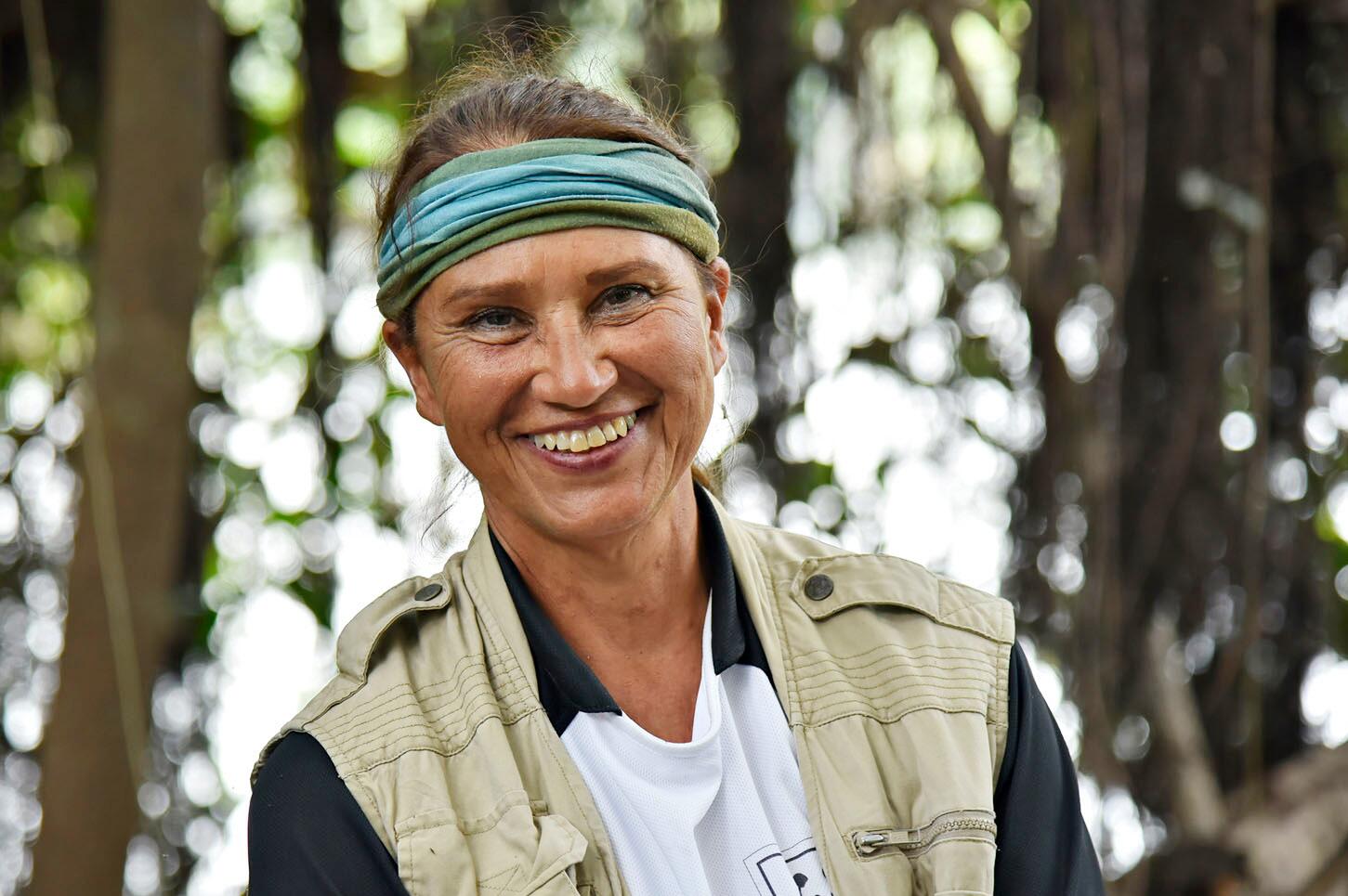The river dolphins of Lake Tefé are disoriented amidst the extreme drought ravaging the Amazon. Their movements are confused, erratic, and agitated and they don’t seem to know where to flee. Many failed to get away. In less than twenty days, the number of deaths reached 139. “It started on Saturday, September 23, when we heard news that eighteen river dolphins had been reported dead. How can this be? It’s unprecedented! So many in just one day? We could hardly image that, just a few days later, there would be seventy more deaths in less than twenty-four hours,” says researcher Miriam Marmontel, who leads a group researching aquatic mammals for the Mamirauá Institute for Sustainable Development, an organization that has researched and conserved Amazonian biodiversity for over twenty years.
Miriam is part of an emergency task force that includes several agencies, put together to discover what is causing the unusual deaths of Amazon river dolphins in the lake region of the Tefé River – the watercourse along which sits the city of the same name, deep in the state of Amazonas, near the spot where it joins the Solimões River. In an interview given by video to SUMAÚMA on October 2, Miriam detailed the dramatic situation in the region and explained the hard work that has been done to identify the cause of the deaths and create strategies to protect these species.
In recent weeks, the drought has lowered the lake’s water level and broken the record for water temperature, which shot from 28 degrees Celsius to 40 degrees Celsius, forming what the researcher describes as a “cauldron of heat, agony, and despair.” “But I suspect there’s something else there to justify so many deaths. Over 10% of the lake’s river dolphin population has already died. Nothing like this has ever happened,” said the oceanographer.
Desperation about what is happening to the aquatic mammals is also echoing among those who have spent decades of their lives studying them. Visibly exhausted, Miriam provided some possible explanations for the tragedy – such as poison, a biotoxin, or even some type of infectious disease – and she talked about how hard it is to transport material collected to major cities for analysis. “The river is dry and hard to navigate.” At various points during the nearly hour-long conversation her voice was overcome with emotion, leaving her unable to describe the horrific scene she had witnessed over the last few days while out on a boat on the muddy lake, trying to find a breath of life among so many bodies. “We see disasters happening around the world and think about how one day it will reach the Amazon. Unfortunately, that day is here.”
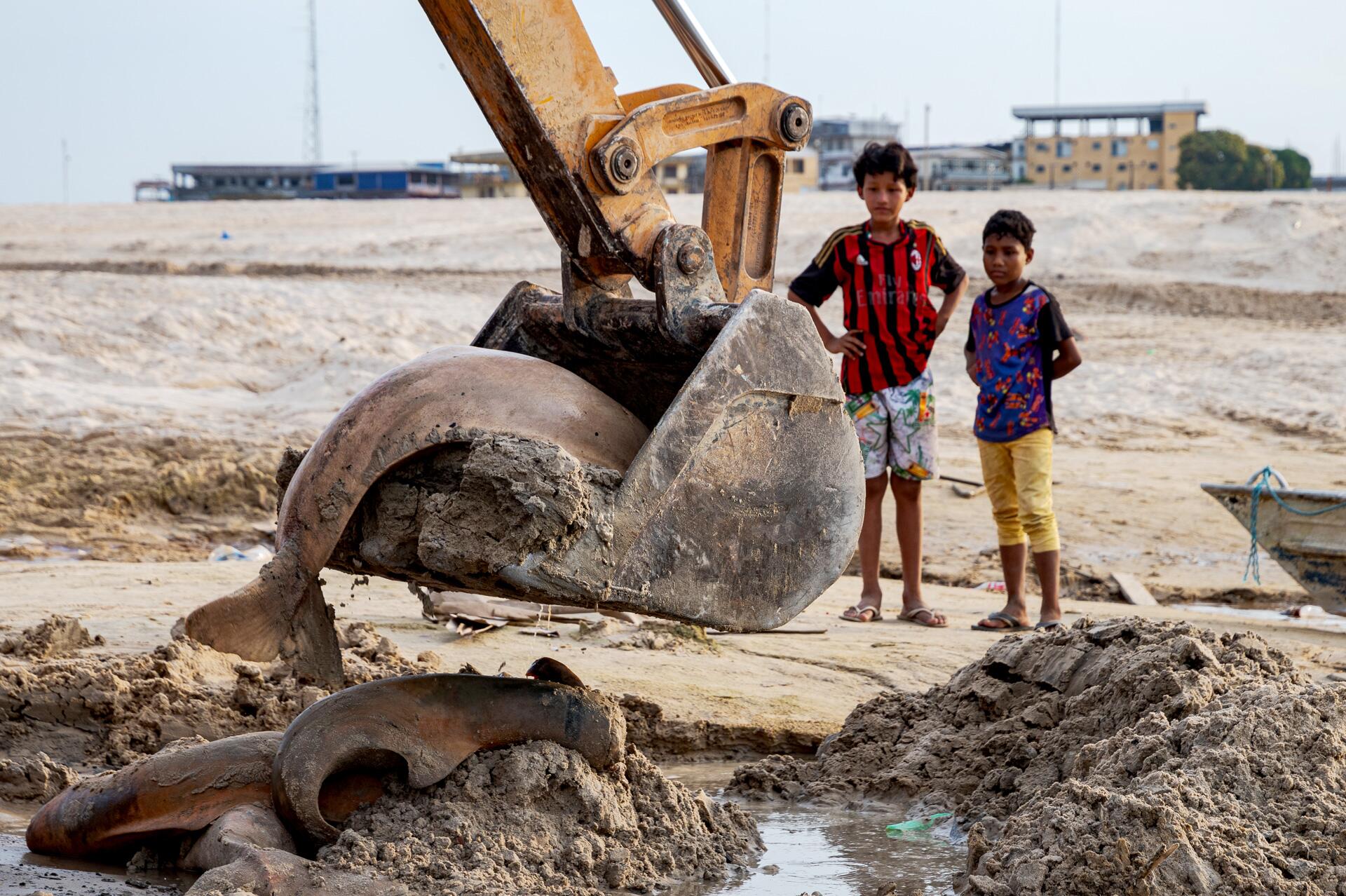
Children watch the removal of river dolphins found dead in the region. Photo: Miguel Monteiro/Instituto Mamirauá
SUMAÚMA: You’ve worked with aquatic mammals for over four decades. In this region alone, you’ve spent thirty years studying river dolphins. Is the current situation really capable of disturbing someone with so many years of experience?
MIRIAM MARMONTEL: Yes, it’s unprecedented. Nothing like this has ever happened before, anywhere. Or with any other species. Never something of this magnitude. We’ve researched river dolphins in the general area of Lake Tefé since 1993, mostly focusing on interactions with fishing, which is the big enemy, the big vector of these animals’ mortality. Yet now we may have a new enemy. We’re suffering from the effects of climate change, caused largely by man. This year we have an exceptional El Niño, with record temperatures throughout the Amazon, throughout the world, and this has clearly affected the animals here. Fortunately, at least up to now, river dolphin deaths are located in Lake Tefé, and this is a region where we already have a research institute, we already know the population’s history, so it’s much easier to try to understand what is happening. But the fact is that Lake Tefé, which is normally a blackwater lake, generally rich in fish and biodiversity, a place where river dolphins live and breed, saw immense drying this year.
But aren’t droughts common at this time of year?
They are common, yes, and we’ve had other extreme droughts. Yet the problem of lake silting is making this period even worse. Silting is caused by changes to the river’s banks, from deforestation that causes sand and sediment to slide into the lake, from people throwing trash into the river bed. It’s a cauldron. This year, at the start of September, the lake began to dry up very quickly, and all of this water reduction raised the temperature to absurd levels. And this set of factors, possibly with something else, is affecting river dolphin health.
Do you all have any guesses as to what is causing these deaths?
We do have some, and we’re trying to eliminate some. It is clear to us that temperature is significantly influencing this scenario. The historical average temperature in Lake Tefé is around 26, 28 degrees Celsius. The high used to be 32 degrees. On the worst day of the recent crisis, on September 28, when seventy river dolphins died, we measured the [temperature of the] water and it was at 40 degrees Celsius. We could immediately sense the discomfort just by placing our hands in the water. Now imagine an animal totally submerged in this water, an animal used to it being at least 8 degrees cooler. It’s ludicrous! We see disasters happening around the world and think about how one day it will reach the Amazon. Unfortunately, that day is here. I imagined this, but I never thought it would actually happen, and suddenly it did.
Couldn’t the high temperature be the sole cause of the deaths?
I suspect that there is something more, because I know these animals. They are under thermal stress, but they’re agile, they’re mobile. Just like the ribeirinhos [traditional forest peoples who live in close proximity to the rivers], they are used to the water’s rise and fall, so they notice when something is different. If it’s going to dry up very quickly, they notice this and can move to the Solimões River. Even with this drought, there is still a channel in the lake, a more restricted and deeper area where boats are able to move and surely the animals as well. What set off this confusion where they didn’t leave? Why did they stay in a place that turned into a pocket of hotter water? They became disoriented. We observed their behavior, and it was erratic. The river dolphins were unable to dive, they kept moving in a circle. They’re having some kind of problem. It could be thermal stress, which lowers immunity, but possibly it’s something more: a pollutant, a biotoxin, a poison that may have been thrown in the water. We still do not have a diagnosis. We’re collecting carcasses.
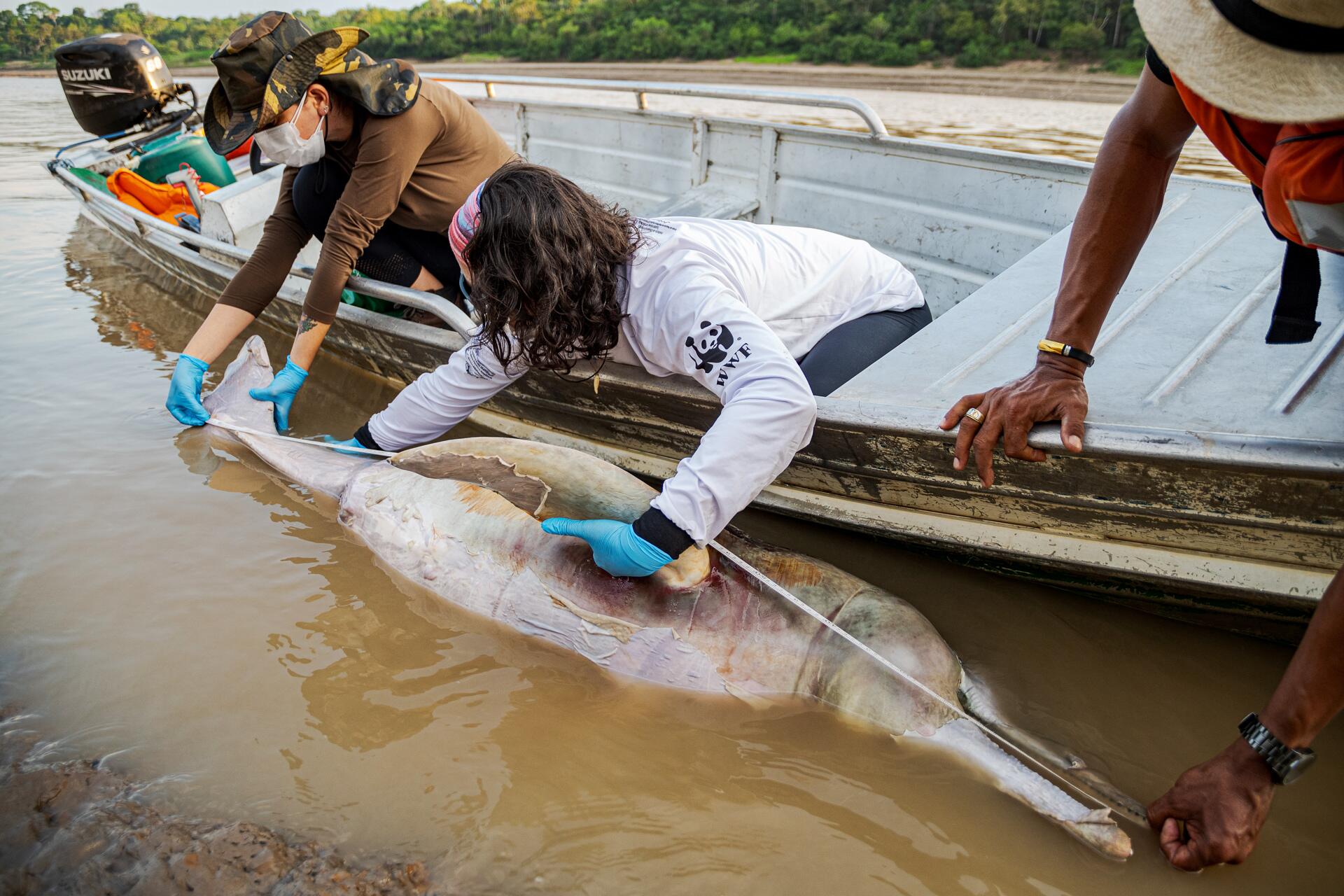
Researchers from Instituto Mamirauá were perplexed by the agony the animals were experiencing. The drought raised water temperatures to 40 degrees Celsius. Photo: Miguel Monteiro/Instituto Mamirauá
What type of analysis could indicate what is happening to these animals?
We have a task force collecting carcasses. The animals who’ve died bear no marks from nets or from aggression. What caught our attention is that their stomachs and intestines are empty; in other words, they’ve apparently gone for days without eating. Yet there’s nothing indicating what may have happened. That’s why we’re investigating at the level of tissue, at the cellular level, to try to identify any microscopic alteration to show us what is happening. Except, at the same time, getting samples out of here for analyses, which can only be done at laboratories in Manaus, São Paulo, and Rio de Janeiro, is a huge problem. It’s a problem because the river is dry, and navigation is difficult. Managing to transport these materials with this degree of urgency is a nightmare.
There are at least 139 dead in Lake Tefé. What is the significance of this in terms of population?
A few years ago we estimated that there were around 900 Amazon river dolphins (Inia geoffrensis) and around 500 tucuxis (Sotalia fluviatilis) in this region. We’ve already lost 10% of the population in recent weeks, and this has an enormous impact. The normal rate of replacement of an aquatic mammal population, or rather, their capacity to grow based on normal rates of mortality, is around 5%. Now, we’ve lost over 10% of the population of species that are already categorized as endangered. We’re in a very critical situation, and the worst part is that it’s not over yet. A recent drop in the temperature has given us a little relief. And right now we’re in a secondary peaking stage, which happens during the dry period, where the river rises slightly and then continues to dry. The problem is that after this secondary peak in the water level, the river starts drying again, and then dries significantly.
You’re accustomed to navigating this lake, to dealing with the animals. What was it like to take a boat out on that fateful day, September 28, when around seventy animals died?
It was devastating to find animals strewn across the beach, in huge amounts along the river. The animals we work with, who are extremely charismatic. Nobody will ever forget witnessing the agony of those river dolphins in those last moments. The animals are usually moving around, the tucuxis jump more, the Amazon river dolphins are more discrete. And on these days we saw the animals were very agitated, trying to dive, some not managing to dive deep. The tucuxis were thrashing around, they were all clearly in agony, tremendous discomfort. While we were very focused on the deaths, the ICMBio [Chico Mendes Institute for Biodiversity Conservation] was also out on the lake, trying to do something for the animals who were alive. We thought that one strategy would be to remove them from the shallower region and direct them toward reservoirs [so that they went toward the Solimões River], but the scenes we witnessed were horrific. For example: when they threw out the net, the animal would go down and never come back up. These scenes were very dramatic, very shocking.
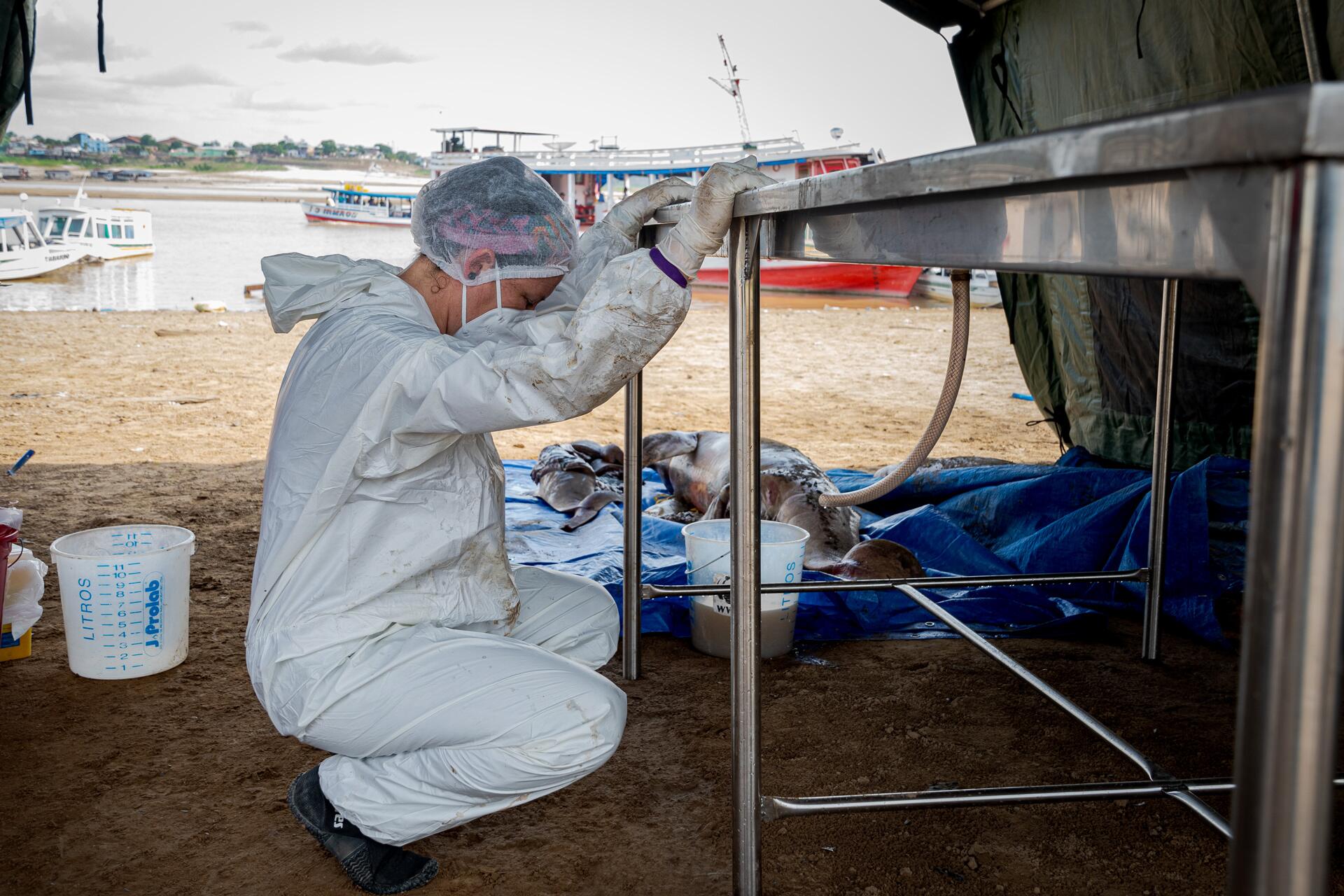
Pain: an employee with the Institute, which is part of a task force collecting the animal’s bodies and researching causes of death, is moved to tears by the devastating situation. Photo: Miguel Monteiro/Instituto Mamirauá
We’re talking now during this secondary peak period, but the lake level should start trending downward again. What do you expect in the coming days, weeks?
Horror, horror. As the secondary swell moves away, the water starts drying up again. And there isn’t hardly any more water in the lake. I don’t know if everything will dry up, if the animals that are already stressed will manage to get out to the Solimões River. I don’t even know if they should get out, if we should help them get out. Because if they have an infectious disease, we won’t be able to transport them. It’s torture, agony not knowing what to do, how to try to help them. We’re also afraid of a new wave of deaths.
You all have studied this region for decades. Wasn’t there any way to predict something like this?
Climate change outlooks have been on the table for years. Many people are skeptical; yet in the meantime, we’re experiencing it. But even knowing this, there was no way for us to predict and prepare ourselves for this. How do you prepare for seventy dead river dolphins in one day? At least everyone mobilized. The city, municipal agencies, the Army, the Navy, universities, NGOs… Everyone sending teams, resources and power, but I don’t know if this will be enough.
What is the long-term impact of these deaths, considering that these are endangered species?
This population will certainly face a setback, because there will be effects in the population dynamics. The rates of births and deaths will not be level, we’ll have a drop in the population, and these animals reproduce very slowly. Recovery will not be fast. The “good thing” is, at least so far, this is only happening in Lake Tefé; it hasn’t affected the entire Amazon. I hope that it doesn’t, but the tendency is for this to happen again next year, the year after that, and perhaps it will reach other basins. That will be much more complicated, because what we are doing here is a war operation. How will we help all of these regions? What could happen is terrifying.
Do you see any future for these species?
If I didn’t, I would have left. That’s why we fight so hard, work so hard. Everyone is engaged, I hope this situation can be reversed. It’s not easy, because it depends on a behavioral change, and this takes time to happen. We’re doing our part here, yet it’s all so little compared to the size of the Amazon.
Proofreader (Portuguese): Valquiria Della Pozza
Translation into Spanish: Meritxell Almarza
English translation: Sarah J. Johnson
Photography editing: Lela Beltrão
Page setup: Érica Saboya
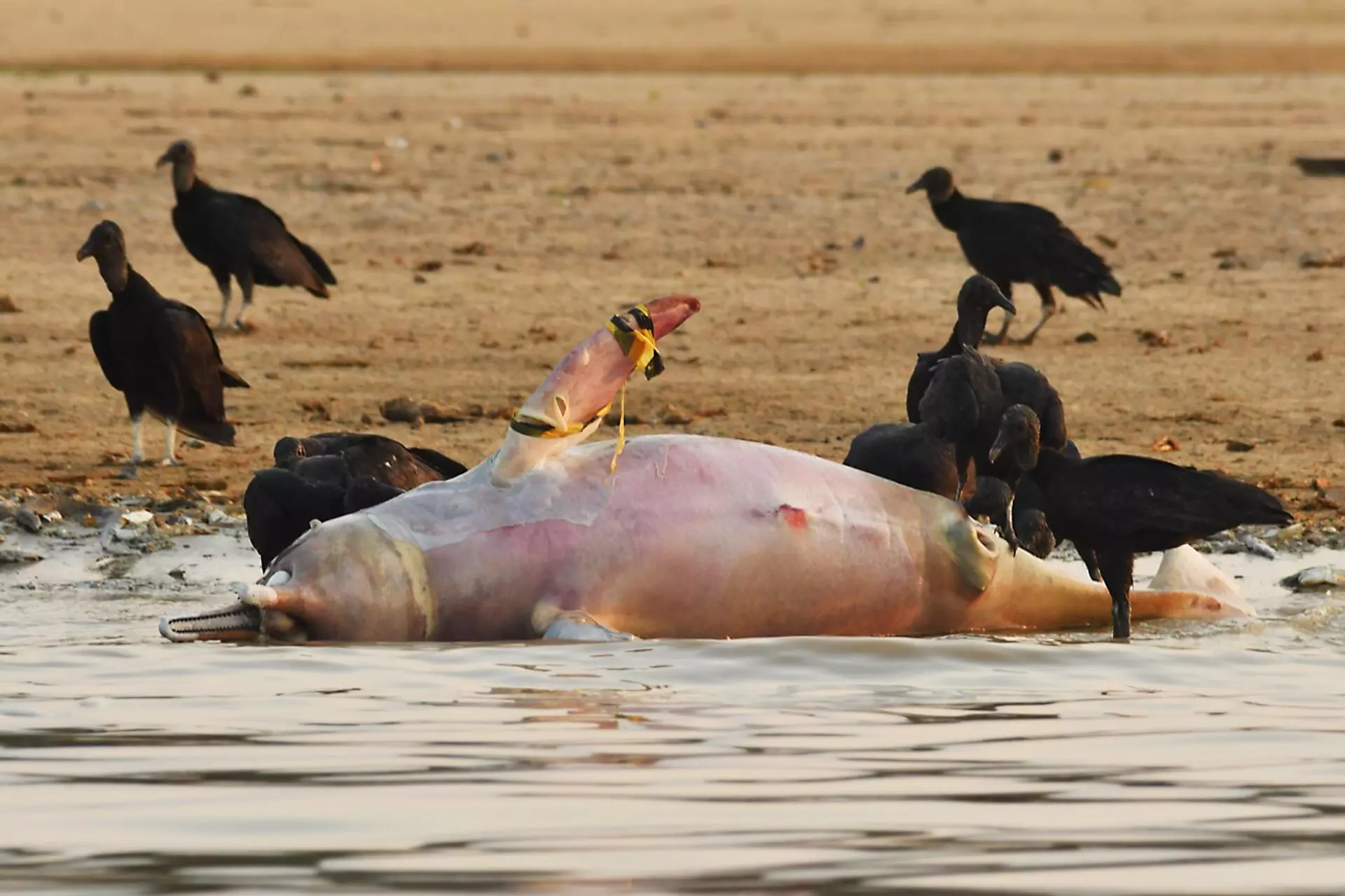
Around 10% of the population of Lake Tefé’s dolphins and tucuxis were exterminated in the last few weeks, a profound impact on the future of this species, which is already endangered. Photo: André Zumak/Instituto Mamirauá




